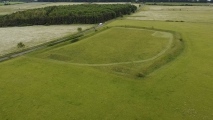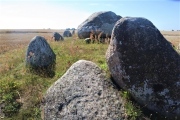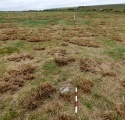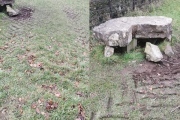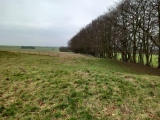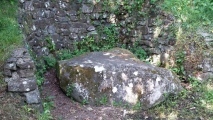Andy Burnham's Blog, page 114
February 22, 2023
Knollbury Enclosure
Knollbury Camp has a single rampart with an in-filled ditch for the entire circuit. A geophysical survey found evidence of a round house and pits, but there have been no excavations on site. #HillfortsWednesday It resembles a Roman fort but no evidence for that, and not located adjacent to a Roman road. Top photo: Viewed from the south.
Published on February 22, 2023 04:06
February 21, 2023
Skegrie Church Long Dolmen
Skegrie Church Long Dolmen is a pleasant site set across the E6 / E22 main road from the church at Skegrie village in Skåne, Sweden. A mound with 15 peripheral stones and an intact south facing chamber covered by a large capstone. Cup marks also visible on the stone in the foreground here. The dolmen is right at the side of the road with a small area for parking next to the "Skegrie dösen" sign.
Published on February 21, 2023 04:19
February 20, 2023
Fron Newydd Stone
A standing stone in Gwynedd that was present on the old 6 inch map and now sadly gone. However David Hoyle has computed a simulation of the sunrise at the summer solstice from this location, pictured. You can view these simulations for other stone sites in England, Scotland and Wales by clicking on the square blue button near the end of External Links on our pages:
Published on February 20, 2023 05:38
February 19, 2023
White Ladder
See the links on our page to download the book Ancient Exmoor (1983) by amateur archaeologist Hazel Eardley-Wilmot (1910 - 1998). A double stone row on Exmoor, the fact that this site is usually masked by peat suggests many more such stone rows still await discovery beneath and within Exmoors peatlands. The impact of climate on these fragile environments - with hotter, drier summers - will no doubt reveal fresh discoveries. It was first discovered by Hazel Eardley-Wilmot in 1975
Published on February 19, 2023 03:29
February 18, 2023
Bessemer Mounds
This cluster of mounds known as the Bessemer Site was the largest indigenous mound site in what is now Jefferson County, and it once dominated a large territory in what became north-central Alabama. In the 1930s, archaeologists and labourers completely excavated all three mounds, so no above-ground evidence remains. Archive photo courtesy University of Alabama. Occupied from about AD/CE 1150 to 1250 during the early Mississippian period, the site included the three mounds near the confluence of Halls Mill Creek and Valley Creek.
Published on February 18, 2023 11:11
February 17, 2023
Nine Maidens Stone Row
Once thought to be the only stone row in Cornwall, but no longer the case with stone rows found on Bodmin Moor, this row is to be found beside the A39 near to Winnards Perch, a few miles southwest of Wadebridge. At the far side of the field are the maidens, nine evenly spaced stones, a couple of which are now only stumps. However, the field and hedges around here are littered with large stones, and there is no doubt that there once could have been many more in this row. The Fiddler stone a few hundred metres to the NNE may be the northern end of this alignment. (see nearby sites list on our page)
Published on February 17, 2023 07:00
February 16, 2023
Knockmaree dolmen
Knockmaree Dolmen was discovered last week with a chunk missing, and track marks visible nearby. More in the comments on our page. Portal Tomb in Co. Dublin. Likely 3300-3500BC. Quite damaged with a concrete support.
In a park next to a gated house. A small road within the park leads you to a former workers house known as Knockmary Lodge. The tomb is located to the right of the lodge on the eastern side. Top photos: Cathy Norris.
In a park next to a gated house. A small road within the park leads you to a former workers house known as Knockmary Lodge. The tomb is located to the right of the lodge on the eastern side. Top photos: Cathy Norris.
Published on February 16, 2023 05:59
February 15, 2023
Monkton Down Long Barrow
Wiltshire Historic Environment Record (HER) notes a possible long barrow aligned east/west, measuring 27m x 13.5m (90 ft x 45 ft) and 1m (3 1/2 ft) high. They think it's doubtful it was one, however stones from a possible kerb/facade or chamber remain at the west end. See the photo on our page for details, also the nearby site listings for more barrows in the area, including Avebury Down Stone Circle, now thought to be the remains of a bell barrow with a massive stone kerb.
Published on February 15, 2023 06:26
February 14, 2023
Rangle Mølle Megalitgrav 2
Megalitgrav in Holbæk, Denmark. A dolmen on a mound. 1.4 x 6.0 x 5.0 meters. The chamber has four orthostats and a single capstone.
Published on February 14, 2023 05:11
February 13, 2023
Blessingstone
The Blessingstone is situated next to a small public park in St Dogmael's Pembrokeshire, on the banks of the Teifi estuary. Apparently if struck soundly an echo is created from the sound bouncing off the opposite bank. The stone has the appearance of a dolmen capstone; reputedly there are other stones nearby which could have been supports (though I didn't see these). It seems a reasonable theory to me. Traditionally up to the Dissolution the Abbot of the neighbouring Abbey would perform an annual ceremony to bless the fishing boats (seine net fishing with coracles, an ancient practice indeed!) from this stone, and the local vicar has revived this custom.
Published on February 13, 2023 11:00

